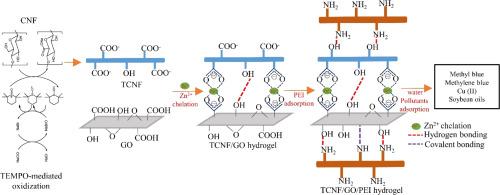Polyethylenimine functionalized graphene oxide and cellulose nanofibril composite hydrogels: Synthesis, characterization and water pollutants adsorption
IF 6.5
Q1 CHEMISTRY, APPLIED
Carbohydrate Polymer Technologies and Applications
Pub Date : 2024-10-11
DOI:10.1016/j.carpta.2024.100585
引用次数: 0
Abstract
A stable 2,2,6,6-tetramethylpiperidine-1-yl)oxyl (TEMPO)-oxidized cellulose nanofibril (TCNF)/graphene oxide (GO)/polyethylenimine (PEI) composite hydrogel was synthesized by self-assembly instead of chemical crosslinking. Their chemical, morphology, surface, and mechanical properties were characterized and adsorption behavior for methyl blue (–) was systematically investigated in terms of the optimal GO content, pH effect, kinetics, and isotherm models. Additionally, to assess the adsorption capability of the TCNF/GO/PEI hydrogel for various contaminants, its effectiveness was also tested for methylene blue (+), Cu (II), and soybean oils. The maximum adsorption capability for the methyl blue (−) dyes increased from 3125 to 3962 mg/g when 13.3 % of GO was added. The adsorption capability for Cu (II) and soybean oils rose from 205.3 to 218.5 and 2.1 to 7.2 mg/g, respectively. The adsorption capability of optimized TCNF/GO/PEI hydrogel for a variety of contaminants was improved overall based on the increase of surface area, electrostatic interactions, and hydrophobic domains. Moreover, adding GO did not impact the adsorption mechanism but increased the external diffusion rate in the intraparticle diffusion model. This work provides a self-assembling route to TCNF/GO/PEI hydrogels with great potential for the removal of multiple water pollutants.

聚乙烯亚胺功能化氧化石墨烯和纤维素纳米纤维复合水凝胶:合成、表征和水污染物吸附
通过自组装而非化学交联合成了一种稳定的 2,2,6,6-四甲基哌啶-1-基)氧化(TEMPO)-氧化纤维素纳米纤维(TCNF)/氧化石墨烯(GO)/聚乙烯亚胺(PEI)复合水凝胶。对它们的化学、形态、表面和机械性能进行了表征,并从最佳 GO 含量、pH 值效应、动力学和等温线模型等方面对甲基蓝(-)的吸附行为进行了系统研究。此外,为了评估 TCNF/GO/PEI 水凝胶对各种污染物的吸附能力,还测试了它对亚甲蓝(+)、铜(II)和大豆油的吸附效果。当添加 13.3 % 的 GO 时,甲基蓝(-)染料的最大吸附能力从 3125 mg/g 增加到 3962 mg/g。铜(II)和大豆油的吸附能力分别从 205.3 毫克/克上升到 218.5 毫克/克和 2.1 毫克/克上升到 7.2 毫克/克。基于表面积、静电相互作用和疏水域的增加,优化的 TCNF/GO/PEI 水凝胶对多种污染物的吸附能力得到了全面提高。此外,添加 GO 不会影响吸附机制,但会增加粒子内扩散模型中的外部扩散速率。这项研究为 TCNF/GO/PEI 水凝胶的自组装提供了一条途径,具有去除多种水污染物的巨大潜力。
本文章由计算机程序翻译,如有差异,请以英文原文为准。
求助全文
约1分钟内获得全文
求助全文

 求助内容:
求助内容: 应助结果提醒方式:
应助结果提醒方式:


